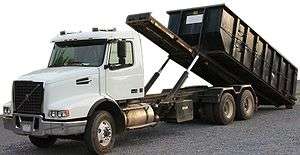Roll-off (dumpster)

A roll-off is a usually open top dumpster characterized by a rectangular footprint, utilizing wheels to facilitate rolling the dumpster in place. The container is designed to be transported by special roll-off trucks. Roll-offs are commonly used to contain loads of construction and demolition waste or other waste types. While most roll-off containers have a swinging door on the end for easier disposal of waste, some roll-off containers are not open top and are used with commercial or industrial trash compactors.
Construction debris may originate from a building site where something is being built, renovated, or demolished. Roll-off dumpsters are also used for various jobs that need much material to be taken away. The material in the roll-off may be taken to a landfill, recycled or disposed/recovered of in some other way.
Size
Roll-off containers have a rectangular footprint typically determined by the size of typical trucks. Roll-off container sizes are determined by the amount of volume of debris they contain. Typical container sizes in the United States are 10, 15, 20, 30, and 40 cubic yards[1] While the roll-offs may be rented by volume, there may be weight limitations. Weight limits may be necessary to ensure compliance with road-use and safety laws and regulations. (or 2-40 cubic meters in other nations).[2]
Most roll-off providers will have a weight limit for each container size. Containers loaded with more weight than allowed typically result in an overage charge. The maximum weight is specified at the beginning of the job. In cases where the material to be disposed of is especially dense, such as concrete, a container with lower sidewalls is used, to help reduce the risk of exceeding the weight limit.
Operation
After the container is picked up, it is taken to a disposal facility where it is weighed before (gross) and after (tare) dumping. The difference is the net weight, and is used to calculate charges to the customer. In order to save time, some facilities pre-record weights of trucks and containers. This allows the tare weight to be looked up and eliminates the need for a second weighing.
Roll-offs are placed by roll-off trucks. As the roll-off truck raises its hydraulically operated bed, the roll-off container rolls off the bed. A cable is used to slowly lower the container. After the waste container is loaded, the roll-off truck pulls the filled container onto the roll-off truck by using a cable and winch system. If the roll-off truck is not a winch system, then it is most likely a hook-lift system. A hook-lift system works by the truck extending a 90 degree arm with a hook on the end which hooks under a bar and gently lifts the dumpster onto the truck. Most hook-lift systems are on smaller roll-off trucks as they are usually used for 20 yard containers and under. These smaller systems are usually the preferred option on smaller scale construction jobs such as roof replacement, kitchen remodels, and garage clean-outs. Smaller single-axle trucks are generally viewed as safer operations as they are much lighter and more easily transported in residential areas. When being carried, the roll-off must be covered.
Disadvantages
One problem often encountered with roll-off containers is the liability of scratching or damaging the surface they are placed on. Most roll-off containers have metal rollers for wheels, which can at times scratch or be abrasive to a concrete or asphalt surface. It is recommended to place a protective board such as plywood under the container to avoid and situation where the placement surface can be damaged. Most roll-off companies do not offer plywood, but will place the container on the wood if supplied. The roll-off must be placed on a hard surface other than dirt. Gravel, asphalt, and concrete are all acceptable. If the container is placed on dirt, the wheels may sink after a rainfall event and the truck could get stuck.
There are many items that are not accepted by roll-off rental companies. These items include but are not limited to chemicals, including paint and petroleum products, tires, and electronics. The prohibition of items is often to comply with laws and regulations concerning disposal of hazardous materials. Roll-off drivers may refuse to pickup loads containing prohibited materials. If the load is picked up, the roll-off rental company may charge the customer additional for cleaning the load and proper handling of the contaminating material.
Legal issues
Some municipalities require that a permit be obtained in order to have a roll-off dumpster delivered. If the container is being set on private property, most cities will not require a permit. Some municipalities require the permit to be obtained by the customer, while others require the permit to be obtained by the roll-off provider. However, many cities do not require permits to have a dumpster delivered.
See also
- Dumpster
- Roller container - A similar container, but a hook-lift is used to roll-off the container.
- Sidelifter - Specialized vehicle for shipping containers.
- Skip (container)
- Waste container
References
- ↑ "Roll-Off Box Sizes". Stanford Buildings & Grounds Maintenance. Retrieved 8 February 2015.
- ↑ "Waste Truck Collection Systems". TruckWorld.com.au. 11 February 2015. Retrieved 12 May 2015.
[Materials Allowed in Roll Off Dumpsters][1]]
- ↑ Austex Dumpsters June 2016
